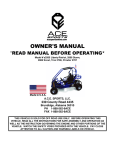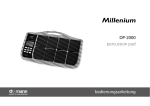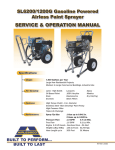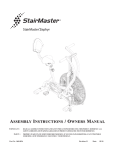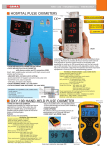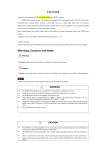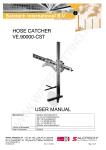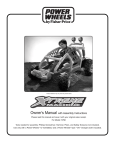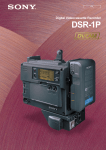Download Ace Sports 2513 Owner`s manual
Transcript
Owners Manual Parts Manual Mini Rover model 2513 This manual contains very important safety information. Please read the entire manual prior to using your Mini Rover. Maintain this manual for future reference. Revision 03.22.06v1 March 14, 2007 Mini Rover Limited Warranty The warranty policy applies to those cases where the new vehicle is unloaded from its shipping container, set up and delivered by an authorized dealer and under normal use and service is found to have defects in parts or workmanship under the following terms and conditions. This warranty covers the Mini Rover and related components, except engine, for a period of 90 days. The engine is warranted by the manufacturer. The engine warranty can be found in the engine manual. This warranty does not apply to any part, which in opinion of the seller, or manufacturer, was defective because of improper maintenance, improper assembly, alterations, abuse, negligence or accident. Should warranty service be required on your Mini Rover during the warranty period, please contact your nearest authorized dealer for repairs. What is not covered under this warranty? Misuse, negligence, alterations, accidents or any abnormal use including non-Genuine parts, renting or leasing, competition or racing. This warranty does not cover loss of use of the unit or loss of time, inconvenience, or normal wear and deterioration caused by the use or storage of consumable items such as spark plugs, chains, brake shoes, fuses, clutch plates, sprockets, light bulbs, battery and tires. A.C. E. Sports, LLC. 239 County RD 4435 Brundidge, AL 36010 (P) 1-888-562-9ACE (F) 1-888-562-8ACE 1 Contents Owners Manual 1. 2. 3. 4. 5. 6. Page Foreword------------------------------------------------------------------------------------------3 Safety----------------------------------------------------------------------------------------------4 Ready to Drive?----------------------------------------------------------------------------------9 Operation----------------------------------------------------------------------------------------12 Adjustments-------------------------------------------------------------------------------------14 Periodic Checks and Services ----------------------------------------------------------------18 Parts Manual 1. 2. 3. 4. 5. 6. Page Frame Group -----------------------------------------------------------------------------------22 Steering Shaft Assembly ---------------------------------------------------------------------24 Suspension Arm Assembly -------------------------------------------------------------------26 Axle Section ------------------------------------------------------------------------------------28 Rear End ----------------------------------------------------------------------------------------30 Wire Elec. Seat ---------------------------------------------------------------------------------32 2 Thank you for purchasing our Mini Rover. We hope you will enjoy it. Before you operate the Mini Rover, please read through this Owner’s Manual carefully as it contains important safety and maintenance information. Failure to follow the warnings contained in this manual can result in serious injuries. Be sure to follow the recommended maintenance schedule and service your Mini Rover accordingly. Preventive maintenance is extremely important to the longevity of your Mini Rover. Beginners should seek instructions from your dealer or qualified instructors before and during initial use of the Mini Rover. It is also recommended to practice in a large open area and to familiarize yourself with the operations of this Mini Rover. We hope you will have a pleasant experience with our products and thanks again for choosing our Mini Rover. 3 SAFETY 2.1 Notes to Parents We know that you, as parent, will have your youngster’s safety foremost in mind. Serious injury can result from the improper use of Mini Rovers. Your youngster’s safety will depend on you taking a “safety first” approach to Mini Rover driving at all times. It is important to carefully read and follow the instructions and warnings contained in this manual and on the labels pasted on the Mini Rover. Once your youngster is ready to learn to drive, you must be familiar with this Mini Rover. You will be serving as teacher, coach, and safety supervisor for your youngster. You must know the controls, handling characteristics, maintenance requirements, and proper driving techniques. Read and understand this manual and labels attached to this vehicle. You must supervise your youngster’s operation of this Mini Rover at all times and permit continual use only if you determine your youngster has the ability and judgement to operate this Mini Rover safely. Teaching your youngster Mini Rover safety is a step-by-step process. It begins with safety rules and moves to actual driving procedures. Since youngsters learn at different rates, it is up to you to set the pace of your youngster’s progress. At some point you may decide that he or she is not ready to drive this Mini Rover. Always closely supervise your youngster’s driving. This is true even if your youngster has learned and mastered the rules and skills of safe Mini Rover driving. Youngsters get tired and become careless easily. They do not always see everything that is important around them. Your close supervision and good judgement are a must. Show your youngster how to use each control as you describe its action. Refer to this manual to learn control location and function before instructing your youngster. Test yourself by operating the controls. Have your youngster dress in proper protective gear and sit in the machine as you point out each control. It is important to have your youngster wear protective gear whenever siting in this Mini Rover. 2.2 Safety Introduction In order to keep everyone safe, you must take responsibility for the safe operation of your Mini Rover. To help you make informed decisions about safety, we have provided operating procedures and other information on labels and in this manual. This information alerts you to potential hazards that could hurt you or others. It is not practical or possible to warn you about all hazards associated with operating or maintaining a Mini Rover. You must use your own good judgement. You will find important safety information in a variety of forms, including: Safety Labels On the kart Safety Messages Proceeded by a safety alert symbol and one of two signal words: WARNING or CAUTION 4 SAFETY WARNING Physical harm may result from failure to adhere to the instructions that are described within the WARNING labels. This entire manual is filled with important safety information. Please read it carefully. 2.3 Protective Gear To parents: Mini Rover driving demands that your youngster wears proper protective gear. Mini Rover drivers should ALWAYS wear a helmet, eye protection, gloves, long pants, a long-sleeved shirt or jacket, and over-the-ankle boots. Anything less is not adequate protection. NEVER let anyone drive a Mini Rover without an approved helmet. Be sure it fits correctly. It should be snug but not tight. It must be properly fastened. Have your youngster wear safety gear whenever getting in a Mini Rover. This action will stress the importance of safety gear and help to develop safe driving habits. Helmets and gloves can be purchased from your dealer. You can also purchase safety gear from A.C. E. Sports Brothers Manufacturing Co. by calling 1-888-562-8ACE or visiting us at wwwacesportsonline.com. 2.4 Safety Information There is much that can be done to protect the operator of the Mini Rover. You will find many helpful recommendations throughout this manual. The following are a few that we consider most important. Always Wear Protective Gear It’s a proven fact that helmets significantly reduce the number and severity of head injuries. Always wear an approved motorcycle helmet, eye protection, sturdy boots, gloves, and other protective gear. Always fasten seat belts. Correctly fastened and adjusted seatbelts will protect the operator and passenger. Drive Off-Road Only Your Mini Rover is designed and manufactured for off-road use only. The tires are not made for pavement. If you need to cross a paved or public road, get off and walk your Mini Rover across. Do Not Operate This Mini Rover at Night Darkness can greatly reduce a driver’s visibility and judgement. Driving at night is dangerous and will increase the possibility of an accident Never Run Your Mini Rover Indoors The exhaust from the engine contains a tasteless, odorless, and poisonous gas called carbon monoxide. 5 SAFETY Keep Away From Moving Parts of the Mini Rover No one should ever place their hands or other parts of their body near any moving part of the Mini Rover. Failure to adhere to this warning will cause physical harm to your body. Skidding or Sliding The terrain surface can be a major factor affecting turns. Skidding in a turn is more likely to occur on slippery surfaces such as snow, ice, mud, and loose gravel. If you skid, you may lose all directional control. To avoid skidding, keep your speed low and drive carefully. Hold On to the Wheel Driving without holding onto the steering wheel is very hazardous. Always drive at a safe speed, depending on the situation. Driving down a slope too fast may result in the Mini Rover overturning. A wet road prolongs the stopping distance of your vehicle. Always take care that you only drive at a speed at which you are able to stop in time. Going downhill at considerable speed may be achieved, requiring a longer breaking time. Taking sharp turns at a high speed may also cause the Mini Rover to overturn. 2.5 Safety Labels This section presents some of the most important information and recommendations to help you drive your Mini Rover safely. Please take a few moments to read the labels on your Mini Rover. (Fig. 1) The labels should be considered permanent parts of the Mini Rover. If a label comes off or becomes hard to read, contact your dealer for warning label replacements. 6 Fig. 1 SAFETY 2.6 Safe Driving Precautions Off- Road Use Only The Mini Rover and its tires are designed and manufactured for off-road use only and not for pavement use. Driving on pavement can cause poor handling and control. Your youngster should not drive the Mini Rover on pavement. WARNING Operating this Mini Rover on paved surfaces may seriously reduce effective handling and control of the Mini Rover, and may cause the kart to go out of control. Never operate the Mini Rover on any paved surfaces, including sidewalks, driveways, parking lots, and streets. When driving off-road, remember to always obey local off-road driving laws and regulations. Obtain permissions to drive on private property. Avoid restricted areas and obey “no trespassing” signs. Keep Hands and Feet on Controls Feet must stay on the foot pedals at all times and hands must stay on the steering wheel. Be sure to stress this important rule. It is important to maintain balance and to control the Mini Rover. Removing hands or feet away from the controls can reduce your ability to react and control the Mini Rover. WARNING Removing hands from Steering wheel or feet from foot controls during operation can reduce your ability to control the Mini Rover or could cause you to lose your balance and fall off the Mini Rover. Always keep both hands on the steering wheel and both feet on the foot controls of your Mini Rover during operation. Hot Components Show your youngster the engine, exhaust pipe, and muffler. Tell him or her not to touch these parts because they are hot. Explain that they will remain hot after the engine is stopped. Also explain that hands and feet must be kept away from all moving parts of the Mini Rover. Inspection Your youngster’s safety depends in part on the condition of the Mini Rover. Be sure to inspect it before each use. Starting and refueling of the vehicle should only be done by responsible adults. Follow a regular maintenance program. 7 SAFETY Adult Supervision Even after young drivers have learned the basic driving skills, direct supervision by an experienced adult is necessary AT ALL TIMES. Make sure that all Mini Rover users under your supervision get proper driving instructions. Follow safety precautions strictly to provide a “safety first” approach to Mini Rover driving. Teaching your youngster how to drive the Mini Rover safely will increase the enjoyment of Mini Rover. Control Speed Driving at excessive speed increases the chance of an accident. In choosing a proper speed, you need to consider the capability of your Mini Rover, the terrain, visibility and other operating conditions, plus operator skills and experience. WARNING Operating this Mini Rover at excessive speed in creases your chances of losing control of the Mini Rover, which can result in an accident. Always drive at a speed that is proper for your Mini Rover. Your speed will be affected by the terrain, visibility and other operating conditions, and your experience. Use Care on Unfamiliar or Rough Terrain Before letting your youngster drive in a new area, always check the terrain thoroughly. Don’t let them drive fast on unfamiliar terrain or when visibility is limited. Watch out for obstructions like hidden rocks, bumps, or holes. WARNING Failure to use care when operating this Mini Rover on unfamiliar terrain could result in the Mini Rover overturning or going out of control. Go slowly and be extra careful when operating on unfamiliar terrain. Always be alert to changing terrain conditions when operating the Mini Rover. Never let your youngster drive past the limit of visibility. Maintain a safe distance between their Mini Rover and other off-road vehicles. Always exercise caution and use extra care on rough, slippery, and loose terrain. 8 Ready to Drive? WARNING Failure to use extra care when operating on excessively rough, slippery, or loose terrain could cause loss of traction or vehicle control, which could result in an accident, including an overturn. Do not operate on excessively rough, slippery, or loose terrain until you have learned and practiced the skills necessary to control the Mini Rover on such terrain. Always be especially cautious on these kinds of terrain. Do Not Perform Stunts Your youngster should always operate their Mini Rover in a safe and reasonable manner. When driving, they should always keep all four wheels on the ground. WARNING Attempting wheelies, jumps, and other stunts increases the chance of an accident, including an overturn. Never attempt stunts, such as wheelies or jumps. Before the Mini Rover is driven for the first time, we urge you to: ♦ Read this owner’s manual and the labels on your Mini Rover carefully. ♦ Make sure you understand all the safety messages. ♦ Know how to operate all the controls and insure your youngster has been taught and understands how to operate all the controls. ♦ Before each drive, be sure your youngster: Wears their seat belts at all times while driving, or sitting in, the Mini Rover. Feels well and is in good physical and mental condition. Is wearing an approved motorcycle helmet (with chinstrap tightened securely), eye protection, and other protective clothing. Do not have any alcohol or drugs in their system. WARNING Operating this Mini Rover without wearing an approved motorcycle helmet, eye protection, and protective clothing could increase your chances of head and/or eye injury. Always wear an approved motorcycle helmet that fits properly and wear eye protection (goggles or face shield), gloves, boots, long sleeved shirt or jacket and long pants. Driver and passenger must always fasten seat belts. 9 Ready to Drive? WARNING Operating this Mini Rover without correctly fastening your seat belt could cause you to be thrown from the vehicle. To parents: One indicator that youngsters are ready to drive a Mini Rover is when they show a safety-conscious attitude and are aware of the dangers of Mini Rover operation. If the youngster has a habit of rashness or is involved in accidents often while using a bicycle or skateboard, the youngster is not ready to drive this Mini Rover. A. The following questions can help parents further pinpoint whether youngster is ready to drive: 1. Can youngster place his or her feet firmly, easily on the foot pedal? 2. Can youngster’s hands reach the steering wheel comfortably? Can your youngster operate the steering wheel? 3. Can youngster push the brake foot pedal brake downward with enough strength to stop the kart? 4. Does your youngster understand the controls of the Mini Rover? B. PRE-DRIVE INSPECTION (to Parents) Before you continue: 1. Have you determined your youngster’s readiness to drive this Mini Rover? Do not let your youngster drive if you have any doubt. 2. Have you read this manual and reviewed it with your youngster? 3. Have you inspected the vehicle and maintained it accordingly? 4. Is your youngster wearing the proper protective gear? 5. Has your youngster learned to locate the Mini Rover controls without help? 6. Does he or she know how to operate the controls smoothly? 7. Does your youngster understand he or she must always drive off-road? 8. Have you stressed to your youngster the importance of keeping his or her feet on the foot pedals and their hands on the steering wheel? C. Practice area (to parents) The best place for learning is a level area 100’ x 200’ that is free from obstacles such as rocks, stumps, or holes. The learning area may have a loose or hard dirt surface. A grassy surface is also acceptable. It should not have two different surfaces. Be sure there is enough room to maneuver, and that no other people or obstacles are close by. D. Getting used to the vehicle in motion (to parents) Be sure your youngster is wearing all of the proper protective gear. With the engines still OFF, have your youngster sit in the Mini Rover. Physically push the vehicle slowly. Practice this several times until you are sure your youngster’s driving skill is developed. Remind your youngster to keep his or her head up and look forward and to keep both feet on foot pedals. 10 Ready to Drive? With the engine off, have your youngster practice smoothly moving the foot pedal throttle control. Your youngster will learn how much pressure it takes to start moving in a later exercise. Explain that pushing the throttle will increase speed. Releasing the throttle and applying the brake will slow the kart down. Ask your youngster to tell you how throttle control and braking affect kart’s speed. With Mini Rover stopped, and engine OFF, have your youngster look in the direction of the turn and turn steering wheel in the direction of the turn. Repeat this exercise while you are slowly pushing your youngster on the Mini Rover. Make sure he or she can turn the vehicle in both directions using this technique. Pre-Drive Inspection Check the following items before you allow anyone on the Mini Rover: Engine Oil Check the level and add oil if needed. Check for leaks. Fuel Check the level and add fuel if needed. Also make sure the fuel cap is securely fastened. Check for leaks. Tires Use a gauge to check the air pressure. Adjust if needed. Also look for signs of damages and excessive wear. Nuts and Bolts Check the wheels to see that the axle nuts are tight. Use a wrench to make sure all accessible nuts, bolts, and fasteners are tight. Underbody & Exhaust System Check for and remove any dirt, vegetation, or other debris that could be a fire hazard or interfere with the proper operation of the Mini Rover. Seat Belt Make sure seat belt locking mechanism is working. 11 OPERATION A. Operation controls WARNING Do not attempt to start or operate the engine until completely familiar with the location and use of each control necessary to operate this vehicle. Your youngster must know how to stop this machine before starting and driving it. Steering Wheel Horn Not Used Kill Button Button Brake Pedal Key Switch Throttle Pedal Fig.2 a. Throttle The right foot pedal is the throttle that controls the Mini Rover speed. As the engine speed increases above idle, the vehicle moves forward. WARNING Each time, prior to starting the engine, check the throttle and brake to ensure that when the pedals are pushed all the way forward the assembly is working smoothly and returns when released. Do not operate if pedals fail to return. If unable to correct the problem through lubrication, adjustment, or replacement of worn parts, contact your dealer for assistance. 12 OPERATION WARNING When starting your Mini Rover the kart should never “buck” or move forward. As the rope is pulled to start the engine, the inertia wheel spins. If the kart moves or pulls forward as the rope start is pulled, the rubber-molded disc is making contact with the inertia wheel and must be correctly adjusted prior to operation. If you are unable to adjust, or feel uncomfortable performing the adjustment, contact your dealer for assistance. b. Brake The brake is located on the left side of the Mini Rover. Applying pressure to the pedal pulls the caliper to the brake disc and slows or stops the kart. WARNING Prior to starting the engine, push the kart forward then apply the brake. If the kart does not stop, the brake is not adjusted correctly. Adjust the brake for correct operation prior to using the Mini Rover. If you are unable to adjust, or feel uncomfortable performing the adjustment, contact your dealer for assistance. c. Start the engine in accordance with the engine manual. 13 ADJUSTMENTS Checking For Correct Operation of the Throttle (Fig. 3-1 and 3-2) With no pressure on the throttle pedal, there should be approximately 1/16” of space between the rubber molded disc (A) and the inertia wheel. (B). When the throttle pedal is depressed, the throttle cable (C) pulls the throttle actuating arm (D) up causing the rubber molded disc (A) to make contact with the inertia wheel (B). Adjusting the Throttle Cable (Fig. 3-1 and 3-2) Remove the bottom cover of the rear end. Loosen the throttle cable retaining nuts (E). Insure that the throttle cable (C) is attached to the throttle actuating arm (D) as shown. Adjust the position of the throttle cable sleeve (F) so that, with no pressure on the throttle pedal, there is 1/16” of space between the rubber molded disc (A) and the inertia wheel (B). Tighten the throttle cable retaining nuts (E). Check to insure there is a 1/16” of space between the rubber molded disc (A) and the inertia wheel (B). Remove the bottom cover of the rear end. Fig. 3-1 Fig. 3-2 WARNING When starting your Mini Rover the kart should never “buck” or move forward. As the rope is pulled to start the engine, the inertia wheel spins. If the kart moves or pulls forward as the rope start is pulled, the rubber-molded disc is making contact with the inertia wheel and must be correctly adjusted prior to operation. If you are unable to adjust, or feel uncomfortable performing the adjustment, contact your dealer for assistance. 14 ADJUSTMENTS Adjusting the Brake Cable Fig. (4-1) depicts the brake caliper with the brake cable correctly installed. The brake cable sleeve (A) must fit inside the keeper (B) as shown. Remove the bottom cover of the rear end. With a #5 Metric Allen head, loosen the brake cable retaining bolt (C). Push up on the brake actuator (D) as shown (Fig. 4-2) and pull the brake cable (E) until it is tight. While maintaining pressure on the actuator, tighten the cable retainer bolt (C). Fig. 4-1 WARNING Prior to starting the engine, push the kart forward then apply the brake. If the kart does not stop, the brake is not adjusted correctly. Adjust the brake for correct operation prior to using the Mini Rover. If you are unable to adjust, or feel uncomfortable performing the adjustment, contact your dealer for assistance. Fig. 4-2 15 ADJUSTMENTS Adjusting the Foot Pedals This Mini Rover has been made with foot pedals that can be moved depending on the size of your child. First remove the bolts (A) and (D) (Figure 5-1 and 5-2). Once you have done this, you are able to move the cable holder and the pedal rod with the pedals together. There is only one bolt that holds the pedal rod in place. On the brake pedal side there is a slot for the pedal rod to fit into, once you have picked out the holes for the new setting, just slide the pedal rod and cable holder together and fasten all bolts and nuts. Remember not to take pedals off the rod. By doing so the spring may come loose. Make sure after you have done the adjustments, the pedals are working and will return to their original position. Fig. 5-1 Fig. 5-2 Adjusting Front Wheel Alignment a. The front wheels should be “toe-in” from 1/8” to ¼”. To check for alignment, measure distance A and B (Fig. 6-1) between the centerline of the wheels. The proper toe-in dimension “A” should be 1/8” to 1/4” greater than dimension “B”. b. To adjust the alignment, loosen the lock nuts (C) on both sides of Front Tie Rods (D). (Fig. 6-2 And 6-3) To make dimension B smaller, turn the rod to the left. Adjust the rod to right direction to make dimension B larger. After adjusting to the desired length, tighten the lock against the rod end. Recheck the dimensions for proper alignment. Fig. 6-1 Fig. 6-2 16 Fig.6-3 ADJUSTMENTS Adjusting the Shocks Changing the settings of all shocks from hard to soft: With a pair of vice grips or channel locks, turn the adjustment knob (A) to the right to decrease stiffness and to the left to stiffen or increase stiffness. Point (B) is the softest setting and point (C) is the hardest setting. Fig. 7-1 17 PERIODIC CHECKS AND SERVICES The maintenance intervals in the following table are based upon average driving conditions. Driving in unusually dusty areas require more frequent servicing. Items Prior to Each use Tire pressure/wear Brake Performance Tightness of Screws Air Cleaner Drive Chain Brake Pad Chassis Fuel tank Battery A: adjust C: clean Monthly Quarterly Yearly I I I C C,L I I I I R R C,I L I I: inspect, clean , adjust, replace if necessary L: lubricate R: replace Engine should be maintained in accordance with the engine manual. 18 This page intentionally left blank. 19 PARTS MANUAL Your dealer can provide technical assistance. You may also contact us. A.C. E. Sports LLC. 239 County RD 4435 Brundidge, AL 36010 Phone: 1-888-562-9ACE Fax: 1-888-562-8ACE www.acesportsonline.com 20 21 FRAME GROUP REF NO PART NO 1 1 1 1 2 2 2 2 3 3 3 3 4 4 4 4 5 5 5 5 6 7 8 9 10 11 12 13 14 15 16 17 18 19 20 21 22 23 24 5121019 5122019 5123019 5124019 5121020 5122020 5123020 5124020 5121021 5122021 5123021 5124021 5121022 5122022 5123022 5124022 5500310 5500320 5500330 5500340 5512503 5572001 5002505 5001046 5001047 5002504 5003003 5003014 5002506 5002507 5512504 5092503 5002508 5092504 5373301 5302503 5512505 5002509 5363020 DESCRIPTION CUSTOM BAR CAGE (BLUE) CUSTOM BAR CAGE (YELLOW) CUSTOM BAR CAGE (RED) CUSTOM BAR CAGE (SILVER) CUSTOM CROSS BAR TOP FR (BLUE) CUSTOM CROSS BAR TOP FR (YELLOW) CUSTOM CROSS BAR TOP FR (RED) CUSTOM CROSS BAR TOP FR (SILVER) CUSTOM J-BAR, L.R. SIDE (BLUE) CUSTOM J-BAR, L.R. SIDE (YELLOW) CUSTOM J-BAR, L.R. SIDE (RED) CUSTOM J-BAR, L.R. SIDE (SILVER) CUSTOM CROSS BAR, R.R. (BLUE) CUSTOM CROSS BAR, R.R. (YELLOW) CUSTOM CROSS BAR, R.R. (RED) CUSTOM CROSS BAR, R.R. (SILVER) FRAME COMP. (BLUE) FRAME COMP. (YELLOW) FRAME COMP. (RED) FRAME COMP. (SILVER) FOAM PADDING - 22 RUBBER PROTECTOR ALLEN HEAD BOLT M8 X 1.25 X 40 ROLL CAGE WASHER, CAP M8 ROLL CAGE NUT, CAP M8 FLANGE BOLT M10 X 1.25 X 50 NUT, M10 LOCKING FLANGE NUT, M10 ALLEN HEAD NUT M8 X 1.25 X 50 FLANGE BOLT M10 X 1.25 X 16 RUBBER FOOT PLATE HORN , H FLANGE BOLT M10 X 1.25 X 10 HORN, L THROTTLE CABLE COMP BRAKE CABLE COMP FOAM PADDING - 30 CUSTOM BAR CAGE CAP STEERING SHAFT BUSH 22 REQD NO 2 2 2 2 1 1 1 1 2 2 2 2 1 1 1 1 1 1 1 1 2 4 6 14 6 2 2 3 8 1 4 1 2 1 1 1 2 8 1 23 STEERING SHAFT ASSEMBLY REF NO PART NO 1 2 3 4 5 6 7 8 9 10 11 12 13 14 14 14 14 15 16 16 16 16 17 18 19 20 21 22 23 24 25 26 27 5362506 5003019 5362503 5362504 5002505 5362505 5362507 5242503 5242504 5003039 5001319 5002510 5002511 5362508 5362528 5362538 5362548 5003006 5522503 5522523 5522533 5522543 5522504 5522505 5363014 5522506 5582504 5582506 5522507 5582507 5372503 5002512 5002513 DESCRIPTION STEERING BOLT COVER LOCKING NYLON NUT M6 STEERING WHEEL STEERING- SHAFT BOLT M6 X 16 STEERING GEAR STEERING BALL JOINT TIE ROD ROD END LOCKING NYLON NUT M8 FLANGE BOLT, M6 X 20 BOLT , M5 X 12 ROLL PIN M3 X 20 STEERING GEAR BRACKET (BLUE) STEERING GEAR BRACKET (YELLOW) STEERING GEAR BRACKET (RED) STEERING GEAR BRACKET (SILVER) LOCKING FLANGE NUT M12 PEDAL BRACKET (BLUE) PEDAL BRACKET (YELLOW) PEDAL BRACKET (RED) PEDAL BRACKET (SILVER) PEDAL BOLT BRAKE PEDAL COMP PEDAL BUSH BRAKE PEDAL RETURN SPRING, R THROTTLE PEDAL RETURN SPRING, L THROTTLE PEDAL COMP RED BRAKE PEDAL PAD GREEN THROTTLE PEDAL PAD STEERING BALL JOINT DUST COVER ALLEN HEAD BOLT M8 X 1.25 X 16 ROLL PIN M3 X 16 24 REQD NO 1 7 1 1 3 1 2 2 2 2 4 2 2 2 2 2 2 1 2 2 2 2 1 1 4 1 1 1 1 1 2 1 2 25 SUSPENSION ARM ASSEMBLY REF NO PART NO 1 2 3 4 5 6 7 8 9 10 11 12 13 14 15 16 17 18 19 20 21 5002514 5363014 5362509 5362510 5001043 5001080 5532503 5002515 5362511 5362512 5212503 5222503 5182503 5222504 5003006 5203004 5002516 5192503 5162503 5212504 5372504 DESCRIPTION FLANGE BOLT M8 X 1.25 X 95 UPPER SUSPENSION ARM BUSH UPPER SUSPENSION ARM COLLAR UPPER SUSPENSION ARM LOCKING FLANGE NYLON NUT M8 FLANGE BOLT M8 X 1.25 X 30 CUSHION ASS'Y. FR FLANGE BOLT M8 X 1.25 X 100 LOWER SUSPENSION ARM COLLAR LOWER SUSPENSION ARM ASS'Y SPINDLE AND STRUT SUPPORT, R BEARING 6202 FRONT WHEEL ASS'Y BEARING 6201 LOCKING FLANGE NUT M12 HUB COVER FR ACORN NUT M10 RIM, FR TIRE, FR 4.1-6 SPINDLE AND STRUT SUPPORT, L BALL HEAD DUST SEAL 26 REQD NO 2 8 2 2 8 4 2 2 2 2 1 2 2 2 2 2 2 2 2 1 4 27 AXLE REF NO PART NO 1 5272503 2 5202503 3 5232503 4 5522508 5 3221001 6 3221009 7 F245 8 F1017 9 5002517 10 3311105 11 5183014 12 5183013 13 5162504 14 5001037 15 5001088 16 5203004 17 5192504 18 5192505 19 5222504 20 5222503 21 5001112 22 5001086 23 5001115 DESCRIPTION AXLE HUB DRIVE SPROCKET BRAKE DISK LUTCO BEARING 20MM w/FLANGE ECCENTRIC LOCK COLLAR (SE20K) BOLT CARRRIAGE 5/16"18 X 3/4" NC NUT FLANGE LOCK 5/16" WHIZ PARALLEL FLAT KEY A M5X50 CHAIN #35-58 PITCHS WHEEL RR KEYED WHEEL RR W BEARINGS TIRE 13X500-6 M16 NUT,CASTLE M12 NUT,CASTLE HUB COVER, RIM KEYED RIM BEARING BEARING,6201 BEARING,6202 BOLT M6X16 LOCK WASHER M6 SET SCREW - MT HUB 28 REQD NO 1 2 1 1 2 2 4 5 3 1 1 1 2 1 1 2 1 1 1 1 8 8 4 29 REAR END REF NO 1 2 3 4 5 6 7 8 9 10 11 12 13 14 15 16 17 18 19 20 21 22 23 24 25 26 27 28 29 30 31 32 33 34 35 36 37 38 39 40 41 PART NO F110 3001549 F422 3001550 3001548 3001551 3001552 F412 F424 3001554 F404 3001069 3451459 3451460 5001306 5001086 3002012 3009009 3402004 3391112 3391113 3311103 3221107 3402284 3441010 3441011 3502500 3452658 3372660 F116 F1003 5003004 5001073 F422 F1017 3130147 5523017 5532504 3372661 5001080 5003039 DESCRIPTION HEX BOLT 5/16" X 3/4" NC CENTER LOCK NUT 7/16" FLAT WASHER 5/16" NUT, 7/16" TAP SCREW 10/24 X 1/4" WOODRUFF KEY #6 CAP SCREW 7/16" X 1" NF LOCK WASHER 7/16" WASHER USS 3/8 BOLT CARRRIAGE 1/4" X 3/4" NC LOCK WASHER 1/4" WHIZ NUT 1/4" NC MFG BUSHING PIVOT 5/8"OD X.328"ID MFG SPACER 1"OD X.455(+/-.005)"ID BOLT M6X16 LOCK WASHER M6 SCREW, 10X3/8 HEX TYA PUSH RETAINER 5/16" EXT FLAG POLE BRACKET INERTIA DISK MOLDED RUBBER DISK CHAIN #35-38 PITCHS BEARING 1 3/8" X 7/16" BEARING BRACKET BLACK SUB PRIMARY SHAFT SUB REDUCTION SHAFT FRAME PAINTED ENGINE MT BUSHING REAR END MT BELLY GUARD BLACK ENGINE MT BOLTS 5/16 x 1 1/4 3/8" SAE FLAT WASHER REAR END MT BOLTS M8 X 50 NUT M8 5/16 FLAT WASHER 5/16 NUT ,WHIZ ENGINE. 3.5 HP TECUMSEH CALIPER ASSY SHOCK REAR ENGINE GUARD FLANGE BOLT M8 X 1.25-30 NYLON LOCK NUT M8 30 REQD NO 1 3 2 1 8 1 1 1 1 1 1 1 1 2 2 2 10 4 1 1 1 1 4 1 1 1 1 1 1 3 4 2 2 2 3 1 1 2 1 4 4 31 WIRE ELEC SEAT REF NO 1 2 3 4 5 6 7 8 9 11 12 PART NO 5371002 3092501 5091023 5091024 5091021 5091022 3092502 5351004 5351005 3092507 3003701 DESCRIPTION REQD NO SWITCH PANEL COVER WIRE HARNESS HORN BUTTON ENGINE STAT BUTTON (NOT USED) ENGINE KILL BUTTON KEY SWITCH W/ KEY BATTERY 12V SEAT SEAT BELT ASSEMBLY BATTERY BRKT SCREW, 10 X 1/2 HEX TYPE 2 32 1 1 1 1 1 1 1 1 1 1 2 This page intentionally left blank. 33


































